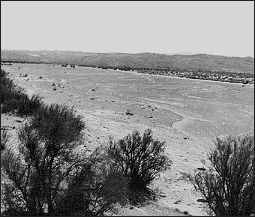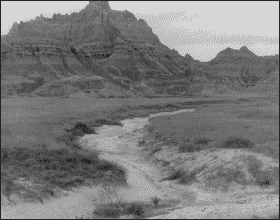
 |
| Plate 37.--Classification: SYSTEM Riverine, SUBSYSTEM Upper Perennial, CLASS Unconsolidated Shore, SUBCLASS Cobble-Gravel, WATER REGIME Temporarily Flooded, WATER CHEMISTRY Fresh. This high-gradient mountain stream arises in the Alaska Range. The gravel piled at the left-hand edge of the photo had accumulated in the channel during flood stage and was bulldozed to its present position to prevent flooding of a highway just downstream. (Fairbanks North Star Borough, Alaska; July 1985; Photo by F. C. Golet) |
 |
| Plate 38.--Classification: SYSTEM Riverine, SUBSYSTEM Intermittent, CLASS Streambed, SUBCLASS Sand, WATER REGIME Intermittently Flooded, WATER CHEMISTRY Mixosaline. The average annual discharge for this river, the Rio Salado, is 14.6 hm³/yr (11,880 acre-ft/yr). (Socorro County, New Mexico; April 1978; Photo by P. B. Reed) |
 |
| Plate 39.--Classification: SYSTEM Riverine, SUBSYSTEM Intermittent, CLASS Streambed, SUBCLASS Mud, WATER REGIME Intermittently Flooded. Streambeds such as this are common throughout the arid West. They carry water for brief periods after snowmelt and following rainstorms which are irregular and unpredictable in occurrence. (Badlands National Monument, Jackson County, South Dakota; May 1985; Photo by F. C. Golet) |
 |
| Plate 40.--Classification: SYSTEM Lacustrine, SUBSYSTEM Limnetic, CLASS Unconsolidated Bottom, SUBCLASS Mud, WATER REGIME Permanently Flooded, WATER CHEMISTRY Fresh. In the narrow Littoral zone of Yellowstone Lake, where water is less than 2 m (6.6 ft) deep, the bottom consists primarily of gravel and sand. (Yellowstone National Park, Teton County, Wyoming; May 1985; Photo by F. C. Golet) |